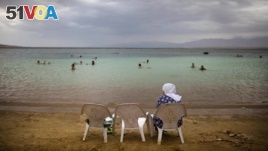02 July, 2017
The Dead Sea is losing about a meter of water each year.
The sea is on the border of Israel and Jordan. It is the lowest place on Earth meaning its surface is farther below sea level than any other place. And the sea's surface is getting lower because of below average rainfall in the area.
Now, an international team of geologists is seeking to understand how climate changes, over 200,000 years, have affected the area. They also may have found that a severe drought deeply changed the Dead Sea thousands of years ago.

Scientists say the surface of the Dead Sea is dropping by about one meter a year. Below average rainfall is causing the sea to lose more water.
The scientists have been studying soil sediment that shows dry seasons and wet seasons over thousands of years.
Marwan al-Raggad studies hydrology, or how water moves on the Earth. He is a member of a team studying the Dead Sea area. He said the group is looking at rocks and soil to find evidence of the climate in the area thousands of years ago. He said he is trying to develop a clear idea of the current conditions in order to "forecast the future climate of the Dead Sea area."
Recently, the team gathered samples from the eastern shore of the Dead Sea and from rivers and streams that flow into it.
Yael Kiro is a geochemist with the Lamont-Doherty Earth Observatory in New York City. She says her group is seeking a better understanding of the area's climate.
"We want to learn what's going on in the Dead Sea in terms of how much water [is coming] from the eastern side and what is the composition of water and what is the composition of sediments. We can't understand without this, the changes that we see in the Dead Sea and therefore we can't understand the climate without knowing what is going on here."
Members of the group said they are finding evidence of a huge drought thousands of years ago. The lack of rains was so severe that it dried up 80 percent of what today is a very salty lake.
Stephen Goldstein also is with the Lamont-Doherty Earth Observatory. He said understanding the past can help plan for the future.
"What happened in the past tells us something about what's possible in the future. And what happened in the past in this area is that the water that people are using now and need now stopped running."
Scientists with the observatory say that the area may have faced two periods of extremely dry conditions. One was 120,000 years ago, the other as recent as 10,000 years ago. During those periods, rainfall dropped to one fifth of its current level. The area is already considered arid, or very dry.
Kiro and Goldstein were among the authors of a study that provided evidence of past periods of extreme drought in the Dead Sea. The study was published in Earth and Planetary Science Letters.
The authors said their findings could be important as current climate models predict that the area may be in another historic dry period.
I'm Mario Ritter.
Faith Lapidus reported this story for VOA News. Mario Ritter adapted it for VOA Learning English. Hai Do was the editor.
_______________________________________________________________
Words in This Story
drought –n. a severe lack of rain
sediment –n. soil or rock that settles to form a layer in the earth
forecast –n. a prediction
composition –n. what makes up a material
We want to hear from you. Write to us in the Comments section, and visit 51VOA.COM.